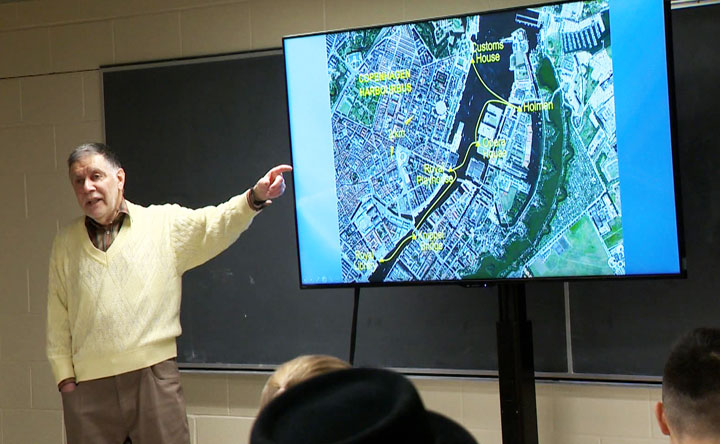A man who studies hydraulic engineering in his spare time says the City of Saskatoon should consider expanding transit off of land and onto an undervalued thoroughfare.

Paul Van Pul is pitching the idea of water buses for public transportation along the South Saskatchewan River. He explained one of his pet projects during a lecture at the University of Saskatchewan on Feb. 14.
“We would have the park-and-rides by the boat bridges or maybe even by the new (Chief Mistawasis Bridge) that was opened up in the north of the city. A park-and-ride for the people that come from outside the city. And then a couple of stops in the city, like by River Heights. Of course, at the university for the students,” he said.
“It’s a lot more relaxing and that’s what we see when you talk with people that in cities that have a water bus. They like it because it’s so quiet, it’s relaxing and going to work, coming from work, you want to relax and that’s what you don’t get on the road.”
A new hydropower station has been proposed at the existing Saskatoon weir to generate 5.5 to 6.1 megawatts of clean power. Saskatoon Light & Power has been studying the potential for the system since 2009.
“For the moment, there aren’t many plans by the city except for the hydropower proposal because the city is not, I think, that interested in the river… nobody looks at the river itself,” Van Pul said.
“The river is considered by in the minds of the people in Saskatoon, I think, as an obstacle. And so the only solution to the obstacle is building more bridges across it. No. We have to look at the river itself too and what the possibilities of the river are… We use it, but we could do better.”
The now-retired land surveyor said he’s taken it upon himself to research the history of hydraulic engineering for roughly the past 30 years. Van Pul added he’s made his case to the city on a number of occasions in the past decade.
“My problem, though, is that (the city) sees more of an advantage in a hydropower proposal. And that’s where I’m scared of the whole thing. Because of the moment they decide they want to build the hydropower station on the weir then we’re stuck for the next hundred years,” he said.
“I think if we look at one project, there should be an alternative. That the citizens of Saskatoon should have the possibility of looking at… let the citizens decide.”
- ‘Shock and disbelief’ after Manitoba school trustee’s Indigenous comments
- Canadian man dies during Texas Ironman event. His widow wants answers as to why
- Several baby products have been recalled by Health Canada. Here’s the list
- ‘Sciatica was gone’: hospital performs robot-assisted spinal surgery in Canadian first

He said it would be important to fuse the proposed urban river transport with Saskatoon Transit.
“If you use a water bus, you have to integrate the river transport with road transport. You want to have a bus pass that works on boats. You have to have connection … and a terminal by the river so people can get seamlessly from the bus to the water bus and vice versa,” Van Pul said.
“They have to use the same pass, the same price range and a timetable that fits in. If it gets organized, it should be by the city transport section that does all the buses in the city. They should have the water bus too.”
Saskatoon Transit said it experienced an increase in annual ridership of around two per cent in 2017, 8.1 per cent in 2018 and 2.5 per cent in 2019. The city is also working on implementing a Bus Rapid Transit (BRT) system as part of its Plan for Growth.
The construction of BRT infrastructure and dedicated transit lanes is scheduled for 2022. June 1, 2025, is the proposed switch to the new BRT service.
While he said the water boats could practically run all year round with the right equipment, Van Pul added there are still questions that need addressing if his concept were to come to fruition.
“I don’t have an answer to that. I’m just the person who throws out the idea, who looked at the possibilities… I hope we can, in the end, have some engineers or scientists that can calculate all the financial details about this system,” Van Pul said.
“But I think it will work and it would. I’m not going to say it’s going to make a profit. The city bus doesn’t make a profit either. But it would be another and more comfortable way of travelling in a city that has a river.”
The weir was initially constructed in 1939 as a water reservoir and regulator of flow through the city. It largely functions as a landmark today.





Comments